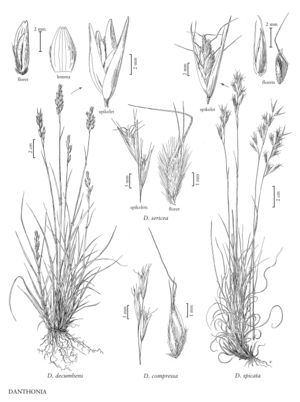Danthonia spicata
Culms (7) 10-70 (100) cm, disarticulating at the nodes when mature. Sheaths pilose or glabrous; blades 6-15 (20) cm long, 0.8-3 (4) mm wide, usually becoming curled at maturity, glabrous or pilose, uppermost cauline blades erect to ascending. Inflorescences with 5-10 (18) spikelets; branches stiff, appressed to strongly ascending after anthesis; lower branches with 1-3 spikelets; pedicels on the lowest branch from shorter than to equaling the spikelets. Spikelets 7-15 mm. Calluses of middle florets about as long as wide, convex abaxially; lemma bodies 2.5-5 mm, usually pilose (sometimes glabrous) over the back, margins pilose to about midlength, longest hairs 0.5-2 mm, apical teeth 0.5-2 mm, acute to aristate, less than 2/3 as long as the lemma bodies; awns 5-8 mm; anthers to 2.5 mm. Caryopses 1.5-2 (2.3) mm long, 0.7-1 mm wide. 2n = 31, 36.
Distribution
Conn., N.J., N.Y., Wash., Del., D.C., Wis., Alta., B.C., Greenland, Man., N.B., Nfld. and Labr., N.S., N.W.T., Ont., P.E.I., Que., Sask., Yukon, W.Va., Mass., Maine, N.H., R.I., Vt., Fla., Wyo., N.Mex., Tex., La., Nebr., Tenn., N.C., S.C., Pa., Va., Colo., Kans., N.Dak., Okla., S.Dak., Alaska, Ala., Ark., Ill., Ga., Ind., Iowa, Idaho, Md., Ohio, Mo., Minn., Mich., Mont., Ariz., Miss., Ky., Oreg.
Discussion
Danthonia spicata grows in dry rocky, sandy, or mineral soils, generally in open sunny places. Its range includes most of boreal and temperate North America and extends south into northeastern Mexico.
Phenotypically, Danthonia spicata is quite variable, expressing different growth forms under different conditions (Dore and McNeill 1980; Darbyshire and Cayouette 1989). Slow clonal growth, extensive cleistogamy, and limited dispersal contribute to the establish¬ment of morphologically uniform populations, some of which have been given scientific names. For instance, D. spicata var. pinetorum Piper is sometimes applied to depauperate plants and D. allenii Austin misapplied to more robust or 'second growth' plants (Dore and McNeill 1980). Plants of shady or moist habitats often lack the distinctive curled or twisted blades usually found on plants growing in open habits. Such plants, which tend to have smaller spikelets and pilose foliage, have been called D. spicata var. longipila Scribn. & Merr. The terminal inflorescence is usually primarily cleistogamous, but plants with chasmogamous inflorescences are found throughout the range of the species. Chasmogamous plants differ in having divergent inflorescence branches at anthesis, larger anthers, and well-developed lodicules.
Selected References
None.
Lower Taxa
"wide" is not a number."decumbent" is not a number.
